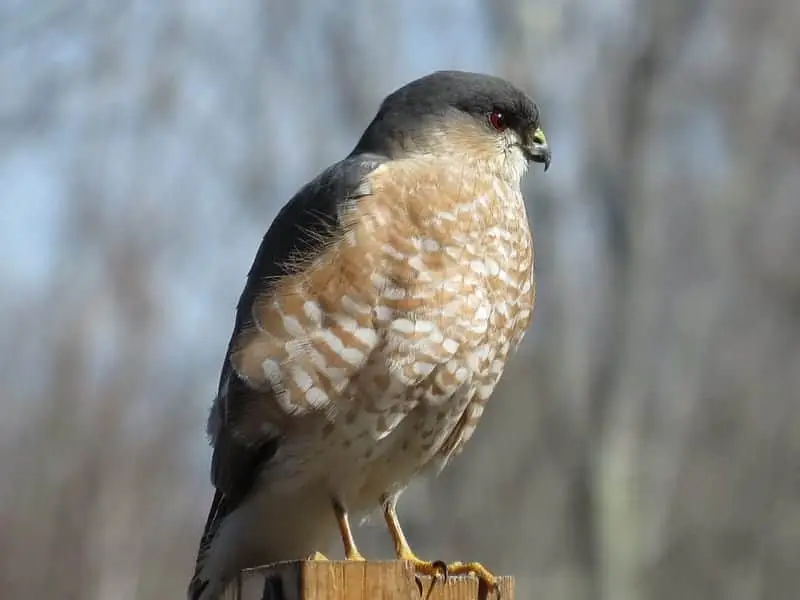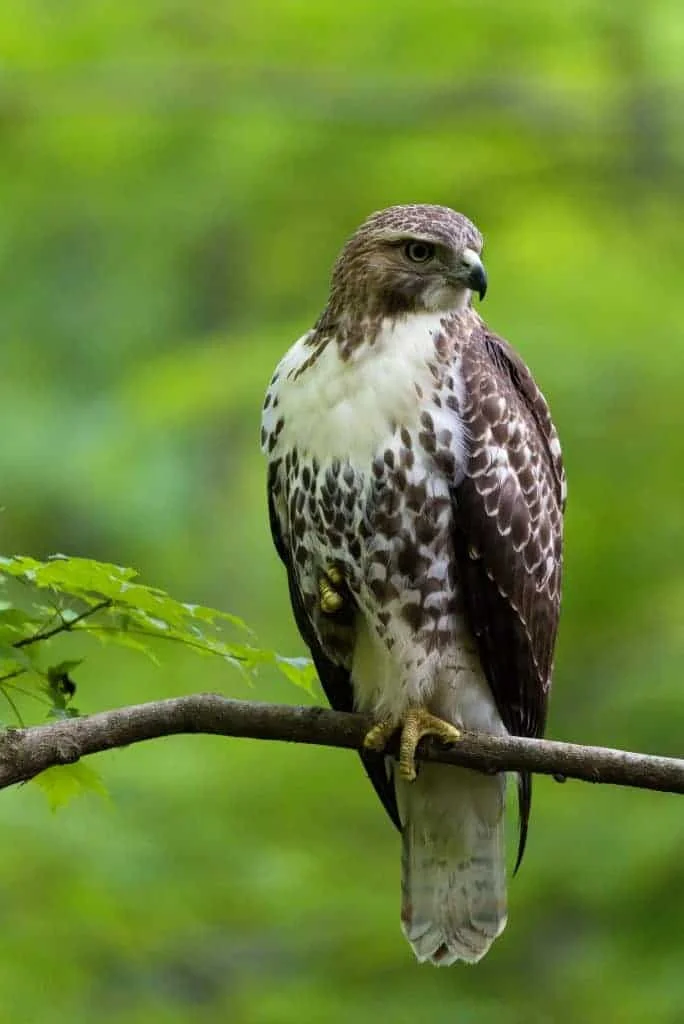In Oregon, it is possible to spot 8 different species of Hawks. These are:
- Red-Tailed Hawk
- Northern Harrier
- Ferruginous Hawk
- Swainson’s Hawk
- Sharp-shinned Hawk
- Cooper’s Hawk
- Northern Goshawk
- Rough-legged Hawk
Want to learn more? This book on the Birds of Prey of North America is a fantastic read!
As Oregon sits at the most northwestern part of the United States, it is in an ideal position to host bird species that thrive in many climates.
There are coastal winds, tall trees, wetlands, mountain perches, and a continual dose of Canadian air to keep flying animals in comfort.
Hawks benefit from the climate itself, as well as the prey it attracts. For bird watchers hoping to spot one, we’ve listed the most likely candidates.
Want to attract birds of prey to your yard? Take a look at our article!
What Hawks can be seen in Oregon?
1. Red-Tailed Hawk

The red tails of their namesake make this hawk one of the easiest to spot among their kind, with radiant red feathers that stand in sharp contrast to the earth tones of its plumage.
They will also have white feathers on the undersides of their wings that stand out from the dark backs and crowns when they fly. Moreover, red-tails are among the largest of the North American hawks.
They are also the most abundant hawk species found in North America, with a presence in most of the mainland states and particular concentration in the northwest near the Canadian border.
Like many of their kin, red tails breed in Canada and fly across its southern border into states like Oregon, Idaho, and Montana when the icy north becomes unbearable in winter.
They often perch on road signs and telephone poles awaiting their prey to scamper by, and are easily recognizable by their screeching calls that are often used for other birds of prey in films.
2. Northern Harrier

These birds can be spotted above open plains and marshlands, ‘harrying’ their prey from above, sometimes remaining airborne for extended periods before landing.
The northern harrier closely resembles a short-eared owl, even mimicking the circle of hardened feathers that make up its faceplate.
They are commonly light to dark grey in the crown and back, with lighter variations of the same color covering the face, though you are just as likely to encounter versions where brown replaces gray, as well as all-grey and all-brown morphs.
The ‘northern’ part of their name refers to a tendency to breed almost exclusively in northern Canada, though they still maintain a year-round presence in the tall forests of Oregon.
3. Ferruginous Hawk

The word ‘ferruginous’ means ‘containing iron’, which in this case refers to the figurative translation that means ‘rust-colored’. This refers to its shoulders, wings, and cape which usually have brownish-red feathers atop stark white patterns underneath.
Facial coloring varies between the same white as the belly, or the same dark brownish-red of its back. Like the Swainson’s hawk, this raptor breeds in the southeast corner of Oregon, though it is less inclined to spread elsewhere.
They are a bit less social than red-tailed hawks, but still more inclined to let humans get close than many others. Watch for the upward tilt of its stark-white wing tips during flight, which stands out among a species that usually holds its wings straight outward.
4. Swainson’s Hawk

These hawks are special, in that they are the only one on this list who does not reproduce mostly in Canada; rather, its North American population breeds entirely in midwest America.
While it is more accustomed to the grassland plains at the center of the country, Swainson’s do drift out toward the west coast as far as Oregon to breed and live sometimes.
They have a similar light underside, dark back and crown of most hawks, in varying shades of gray and brown, with the darker shades interrupting the light ones on the belly and face with sporadic markings.
They are equally likely to perch and strike as they are to circle the open marsh and grasslands, and they will even land and chase their prey on foot.
They breed heavily in the southeastern tip of Oregon, so their population is most prevalent as you head in that direction.
5. Sharp-shinned Hawk

This is the most well-traveled of all on this list, with an all-year presence throughout Oregon and a breeding population along the easter border to Idaho.
They are also the most social, moving in large flocks called kettles in the winter and displaying peculiar group hunting behavior compared to their more isolationist cousins.
Physically, sharp-shinned hawks resemble the Cooper’s hawk listed below, with rust and white striped undersides and a blue-gray back, wings, and crown.
They differ from the Cooper’s in that they are smaller, have slightly rounder heads, usually have a bit more rust coloring about the neck, and of course the trademark sharp shins that are difficult to spot from a distance.
6. Cooper’s Hawk

This hawk is a larger replica of the sharp-shinned hawk listed above, with the same blue-gray wings, back, and crown, and a rust and white striped pattern about its belly and face.
Sightings aren’t consistent because they’ll often remain north in mild winters, but there are records of repeat visits in the southeast part of Oregon which spread throughout the state in a non-breeding capacity all year-round.
They are stealth hunters, meaning sightings can be rare even in populated areas, but open wetlands and riparian zones near tall treelines is a good place to start.
7. Northern Goshawk

These are the sleek dogfighters of the accipiter family, known for snatching songbirds from mid-air in dazzling displays of aerial agility.
Like the harrier, the ‘northern’ portion of its name explains that it breeds almost exclusively in the far north of Canada, though Oregon remains a year-round nesting and hunting destination.
They will occasionally overwinter in the southeastern part of the state, where many other hawks like to gather when it’s cold. They are easily recognized as the largest of their kind (accipiters) in North America, as well as an uncommon color scheme.
Goshawks usually have dark gray or brown tails, and crowns, with a whitish pattern on the belly and wing undersides that have specks of the darker color throughout appearing as stripes in some.
Many have the black patch of feathers about both eyes, giving the bandit’s mask and completing the image of a very large songbird with sharper beak and talons.
8. Rough-legged Hawk

The rough-legged hawk stays in Oregon all year, roaming south from Canada to hunt and nest between breeding.
This bird follows sporadic migratory patterns–abundant one year, missing the next–but they do maintain a consistent presence of birds fleeing the Canadian winter.
Their namesake is derived from the feathers which extrude from their lower bodies across their legs, giving them a rough appearance.
The coloring of a rough-legged hawk varies between stark white and different shades of brown, generally a toss-up between a mostly-white with brown accents or the other way around.
White feathers decorate the underside of their wings, and some have dark patches across the shoulders and chest, providing further identifying markers.
References
- https://wildlifeinformer.com/hawks-in-oregon/
- https://www.audubon.org/field-guide/bird/northern-harrier
- https://www.audubon.org/field-guide/bird/swainsons-hawk
- https://www.audubon.org/field-guide/bird/ferruginous-hawk
- https://www.audubon.org/field-guide/bird/northern-goshawk
- https://www.audubon.org/field-guide/bird/sharp-shinned-hawk

About Us
We are avid bird-watchers who recently retired, allowing us more time to travel the world. Fortunately, we have managed to visit numerous countries around Europe, Asia, and America. Watching and photographing birds has been a passion for many years and we are making the most of the extra time on our hands!

